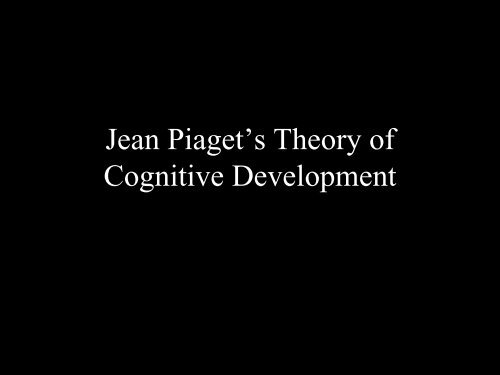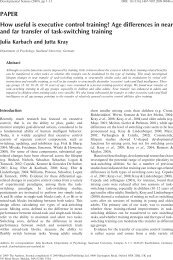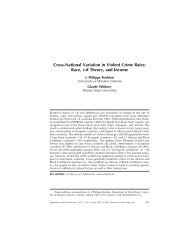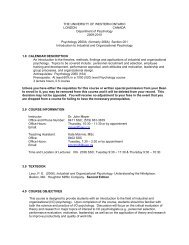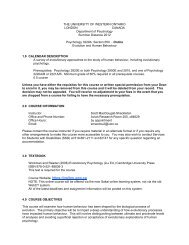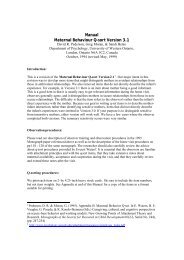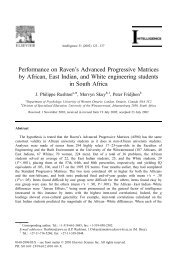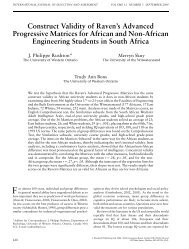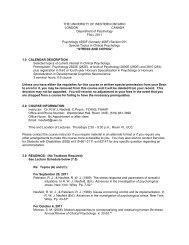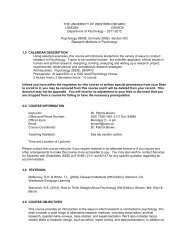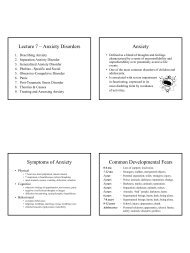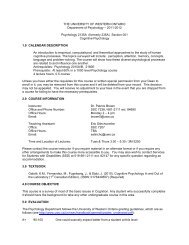Jean Piaget's Theory of Cognitive Development - Psychology
Jean Piaget's Theory of Cognitive Development - Psychology
Jean Piaget's Theory of Cognitive Development - Psychology
Create successful ePaper yourself
Turn your PDF publications into a flip-book with our unique Google optimized e-Paper software.
<strong>Jean</strong> Piaget’s <strong>Theory</strong> <strong>of</strong><strong>Cognitive</strong> <strong>Development</strong>
<strong>Jean</strong> Piaget 1896-1980
Sensorimotor Stage0-24 monthsSubjective ObjectivePreoperational Stage2-7 yearsConcrete AbstractConcrete Operations7-11 yearsUncoordinated Coordinated
The Sensorimotor Stage• Basic reflexes or schemes• Primary & secondary circular reactions• Objects as sensory pictures• Objects and schemas indistinguishable– A not B error• 24 months: Object permanence– Objectivity and subjectivity distinguished
Pre-operational Stage• What logical principles are mastered in thePre-operation stage?
Pre-operational Stage• What logical principles are mastered in thePre-operation stage?(1) Reversibility: Pouring water into thetall container can be reversed.
Pre-operational Stage• What logical principles are mastered in thePre-operation stage?(2) Compensation: Change in heightcompensated by change in width.
Pre-operational Stage• What logical principles are mastered in thePre-operation stage?(3) Identity: No amount <strong>of</strong> liquid has beenadded or taken away.
Pre-operational Stage• Without operations, children’s thinking is:1. Intuitive, perceptually-driven2. Uncoordinated3. Egocentric
Pre-operational Stage• Without operations, children’s thinking is:1. Intuitive, perceptually-driven2. Uncoordinated3. Egocentric• Observed across tasks and domains– Thus considered a “stage” <strong>of</strong> development
Concrete Operations• Actions internalized & mentally simulated• Forms the basis <strong>of</strong> logical operations
Evaluating Piaget• Highly original thinker– Neither an empiricist nor a nativist• Enormous scientific contributions– Errors and methods; developmental invariants• Challenging– Dense writing style & broad theoretical scope• Controversial– Competence-Performance distinction
Does performance under-estimate competence?• Piaget’s tasks challenging• Distractions, reaching, etc.
Looking timeHabituation procedure
Looking timeHabituation procedure
Looking timeHabituation procedure
Looking timeHabituation procedure
Looking timeHabituation procedure
Looking timeHabituation procedure
Looking timeHabituation procedure
Looking timeHabituation procedure
Looking timeHabituation procedure
Looking timeHabituation procedure
Object Permanence• Baillergeon, 1986• Used habituation procedure to assess object permanencein 6-month-old infants.
Habituation Display
Test 1: Possible Event
Test 2: Impossible Event
Results and conclusions• 6- month-olds looked longer to impossible than possibletest events.• Young infants understand that objects continue to existafter being hidden behind a screen.
Jerome BrunerConservation Tasks
Jerome BrunerConservation Tasks
Challenges for Piaget• If object permanence achieved at 6-months, why do 12month-olds commit the A not B error?• If children understand the concept <strong>of</strong> conservation, whydo they fail the tasks?• What is developing?
Information Processing Perspective• American tradition <strong>of</strong> experimental psychology• Thinking is information processing• Computer as a metaphor• Example: Atkinson & Shiffrin’s store model
Atkinson & Shiffrin’s store modelStimulusSensory registerShort-termmemoryLong-termmemoryExecutive functionsResponse
Atkinson & Shiffrin’s store modelStimulusSensory registerShort-termmemoryLong-termmemoryExecutive functions• Temporary cache• Infinite Response capacity• Brief duration
Atkinson & Shiffrin’s store modelStimulusSensory registerShort-termmemoryLong-termmemoryExecutive functions• Limited capacity (5 to 7 chunks <strong>of</strong>information) Response• Temporary storage
Atkinson & Shiffrin’s store modelStimulusSensory registerShort-termmemoryLong-termmemoryExecutive functions • Infinite capacity• Long-term storage• Procedural & declarative memoryResponse
Procedural memory“Can you show me how to make a cake?”
Declarative memoryProcedural memory“Can you show me how to make a cake?”“What was your birthday cake like?”
Atkinson & Shiffrin’s store modelStimulusSensory registerShort-termmemoryLong-termmemoryExecutive functionsResponse
Atkinson & Shiffrin’s store modelStimulusSensory registerShorttermmemoryLong-termmemoryExecutive functionsResponseNew approach to understanding the A not B error
Role <strong>of</strong> STM• B trials: New hiding location needs to be keptin short-term memory• Do errors reflect age-related STM constraints?
Role <strong>of</strong> STM• B trials: New hiding location needs to be keptin short-term memory• Diamond (1985)• Do errors reflect• Longitudinalage-relatedstudySTM constraints?• BTW 7 & 12 months, lab visit every 2 wks• Each visit, A not B assessed.• Delay between hiding at B and search varied.
ResultsMaximum delay
Results• Across all ages:– A not B errors more likely at longer delays• Older infants:– Sustain longer delays.STM capacity may constrain infant A not B task performance
Atkinson & Shiffrin’s store modelStimulusSensory registerShort-termmemoryLong-termmemoryExecutive functionsResponse
1. Memory in infancy<strong>Development</strong> <strong>of</strong> LTM• 3-month-olds• Train on A• Test on A & B, 2 weeks later• More kicking for A than B• Infant form LTMsRovee-Collier & Hayne, 1987
2. Infantile Amnesia<strong>Development</strong> <strong>of</strong> LTMThe failure to RECALL AUTOBIOGRAPHICALEVENTS from the first 2 or 3 years <strong>of</strong> life.
2. Infantile Amnesia<strong>Development</strong> <strong>of</strong> LTMThe failure to RECALL AUTOBIOGRAPHICALEVENTS from the first 2 or 3 years <strong>of</strong> life.Rouge test & the importance <strong>of</strong> self-recognition
<strong>Development</strong> <strong>of</strong> LTM3. Learning to Use Memory
Serial Position Effect in RecallProportion Correct10090807060504030201001st 2nd 3rd 4th 5th 6th 7thSerial PositionAdults
Serial Position Effect in RecallProportion Correct10090807060504030201001st 2nd 3rd 4th 5th 6th 7thSerial PositionRecency EffectAdults
Serial Position Effect in RecallProportion Correct100908070605040302010Reflects short-termmemoryRecency EffectAdults01st 2nd 3rd 4th 5th 6th 7thSerial Position
Serial Position Effect in RecallProportion Correct1009080706050403020100Primacy Effect1st 2nd 3rd 4th 5th 6th 7thSerial PositionAdults
Serial Position Effect in RecallProportion Correct100908070605040302010Primacy EffectReflects transfer tolong-term memoryAdults01st 2nd 3rd 4th 5th 6th 7thSerial Position
Serial Position Effect in RecallProportion Correct10090807060504030201001st 2nd 3rd 4th 5th 6th 7thSerial PositionAdults8-yr
Serial Position Effect in RecallProportion Correct10090807060504030201001st 2nd 3rd 4th 5th 6th 7thSerial PositionRecency EffectAdults8-yr
Serial Position Effect in Recall100Recency EffectProportion Correct908070605040302010No age effect inshort-term memoryAdults8-yr01st 2nd 3rd 4th 5th 6th 7thSerial Position
Serial Position Effect in Recall100Proportion Correct908070605040302010No Primacy EffectAdults8-yr01st 2nd 3rd 4th 5th 6th 7thSerial Position
Serial Position Effect in Recall100Proportion Correct908070605040302010No Primacy EffectLess transfer to long-termmemory in childrenAdults8-yr01st 2nd 3rd 4th 5th 6th 7thSerial Position
Serial Position Effect in Recall100Proportion Correct908070605040302010No Primacy EffectWHY?Less transfer to long-termmemory in childrenAdults8-yr01st 2nd 3rd 4th 5th 6th 7thSerial Position
Rehearsal• A memory strategy that involves repetition<strong>of</strong> items to be remembered.• Children learn that rehearsal promotesmemory.
Flavell, Beach, & Chinsky, 1966Kindergarteners:2 nd -graders5 th -graders
Flavell, Beach, & Chinsky, 1966Kindergarteners:2 nd -graders5 th -graders
Flavell, Beach, & Chinsky, 1966DelayKindergarteners:2 nd -graders5 th -graders
Flavell, Beach, & Chinsky, 1966Recall?Kindergarteners:2 nd -graders5 th -graders
Flavell, Beach, & Chinsky, 1966Recall?Kindergarteners:2 nd -graders5 th -gradersImprovement
Flavell, Beach, & Chinsky, 1966Rehearsal?Kindergarteners:2 nd -graders5 th -graders
Flavell, Beach, & Chinsky, 1966Rehearsal?Kindergarteners:2 nd -graders5 th -graders: 85%
Flavell, Beach, & Chinsky, 1966Rehearsal?Kindergarteners: 10%2 nd -graders5 th -graders: 85%
Flavell, Beach, & Chinsky, 1966Rehearsal?Kindergarteners: 10%2 nd -graders5 th -graders: 85%Rehearsal Better Recall
Rehearsal• A memory strategy that involves repetition<strong>of</strong> items to be remembered.• Children learn that rehearsal promotesmemory.
Rehearsal• A memory strategy that involves repetition<strong>of</strong> items to be remembered.• Children learn that rehearsal promotesmemory.• Change in the nature <strong>of</strong> rehearsal?
Ornstein, Naus, & Liberty, 1975Rehearsal SetsWord Presented 8 th -graders 3 rd -gradersYardCatManDesk
Ornstein, Naus, & Liberty, 1975Rehearsal SetsWord Presented 8 th -graders 3 rd -gradersYardYard, yard, yardCatCat, yard, cat, yardManMan, cat, yard, man, cat…DeskDesk, man, cat, yard, desk...
Ornstein, Naus, & Liberty, 1975Rehearsal SetsWord Presented 8 th -graders 3 rd -gradersYard Yard, yard, yard Yard, yard, yardCat Cat, yard, cat, yard Cat, cat, cat, cat, yardMan Man, cat, yard, man, cat… Man, man, man, manDesk Desk, man, cat, yard, desk... Desk, desk, desk, desk
Organization & Elaboration• Organization A memory strategy thatinvolves organizing list items intocategories
Organization & Elaboration• Organization A memory strategy thatinvolves organizing list items intocategoriesDog, chair, cat, cow, table, horse
Organization & Elaboration• Organization A memory strategy thatinvolves organizing list items intocategoriesDog, chair, cat, cow, table, horse10 & 11 yr-olds Dog, cat, cow,horse, table, chair
Organization & Elaboration• Organization A memory strategy thatinvolves organizing list items intocategoriesDog, chair, cat, cow, table, horse10 & 11 yr-olds Dog, cat, cow,horse, table, chair5 & 6-yr-olds Dog, chair, cat…
Organization & Elaboration• Organization A memory strategy thatinvolves organizing list items intocategories: Greater use in older children
Organization & Elaboration• Organization A memory strategy thatinvolves organizing list items intocategories: Greater use in older children• Elaboration A memory strategy in whichitems are linked through use <strong>of</strong> an image orsentence
Organization & Elaboration• Organization A memory strategy thatinvolves organizing list items intocategories:Woman,Greaterpink,usecomputerin older children• Elaboration A memory strategy in whichitems are linked through use <strong>of</strong> an image orsentence
Organization & Elaboration• Organization A memory strategy thatinvolves organizing list items intocategories:Woman,Greaterpink,usecomputerin older children• Elaboration A memory strategy in whichitems are linked through use <strong>of</strong> an image orsentence
Organization & Elaboration• Organization A memory strategy thatinvolves organizing list items intocategories: Greater use in older children• Elaboration A memory strategy in whichitems are linked through use <strong>of</strong> an image orsentence: Greater use in older children
Rehearsal• A memory strategy that involves repetition<strong>of</strong> items to be remembered.• Children learn that rehearsal promotesmemory.• Change in the nature <strong>of</strong> rehearsal?
Rehearsal• A memory strategy that involves repetition<strong>of</strong> items to be remembered.• Children learn that rehearsal promotesmemory.• Change in the nature <strong>of</strong> rehearsal
Conclusions


